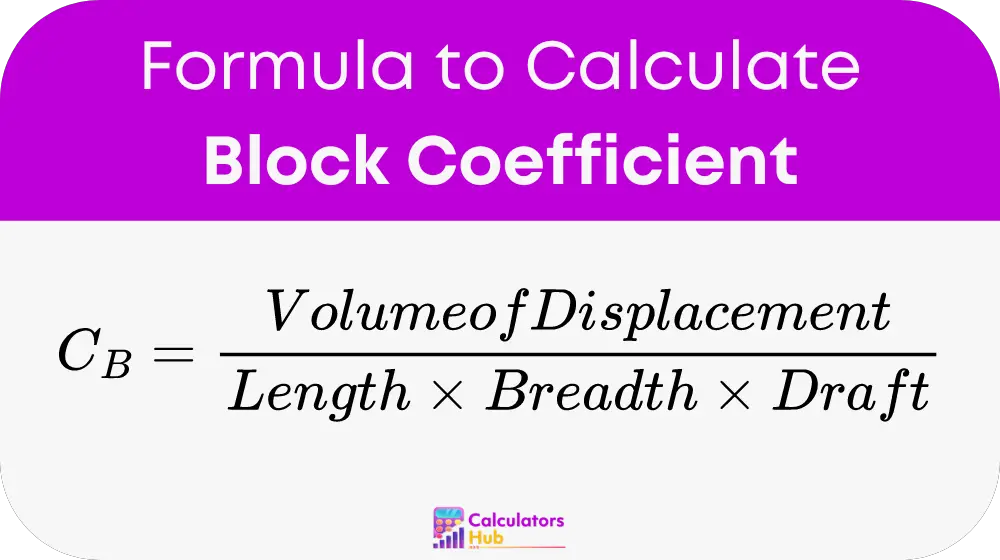The Block Coefficient Calculator is an essential tool in naval architecture and ship design. It helps in determining the block coefficient (C_B) of a ship, which is a dimensionless measure that describes how much of the ship's volume is occupied relative to a rectangular block with the same overall dimensions (length, breadth, and draft). The block coefficient plays a critical role in assessing a ship’s hydrodynamic efficiency, stability, and overall performance in water. It aids designers and engineers in optimizing the hull shape for specific performance characteristics, such as speed, cargo capacity, and fuel efficiency.
Formula of Block Coefficient Calculator
To calculate the block coefficient, the following formula is used:

Where:
- Volume of Displacement: The volume of water a ship displaces at a particular draft, usually measured in cubic meters or cubic feet.
- Length: The length of the ship at the waterline level or overall length.
- Breadth: The maximum breadth of the ship.
- Draft: The vertical distance between the waterline and the lowest point of the ship's hull (keel).
This formula provides a ratio that indicates how full the ship’s hull is compared to a rectangular block with the same dimensions. A higher block coefficient suggests a fuller hull, which may indicate better cargo capacity but potentially lower speed. Conversely, a lower block coefficient suggests a more streamlined hull, which may indicate higher speed but reduced cargo capacity.
General Terms and Conversions
To assist in understanding and using the Block Coefficient Calculator effectively, the table below provides common values and their corresponding block coefficients. This table serves as a quick reference for ship designers and engineers who want to estimate the block coefficient without detailed calculations.
| Ship Type | Volume of Displacement (cubic meters) | Length (meters) | Breadth (meters) | Draft (meters) | Block Coefficient (C_B) |
|---|---|---|---|---|---|
| Cargo Ship | 100,000 | 200 | 30 | 10 | 0.833 |
| Tanker | 150,000 | 250 | 40 | 12 | 0.781 |
| Container Ship | 80,000 | 220 | 32 | 11 | 0.745 |
| Passenger Cruise | 120,000 | 270 | 35 | 8 | 0.787 |
| Fishing Vessel | 5,000 | 60 | 10 | 4 | 0.833 |
This table provides general values, making it easier for users to quickly assess the block coefficient for different types of ships based on their dimensions and displacement volume.
Example of Block Coefficient Calculator
Let’s go through an example to demonstrate how to use the Block Coefficient Calculator effectively.
Example Scenario:
Assume you have a cargo ship with the following dimensions:
- Volume of Displacement: 120,000 cubic meters
- Length: 250 meters
- Breadth: 32 meters
- Draft: 12 meters
Using the formula:
- Block Coefficient (C_B) = Volume of Displacement / (Length × Breadth × Draft)
- Block Coefficient (C_B) = 120,000 / (250 × 32 × 12)
- Block Coefficient (C_B) = 120,000 / 96,000
- Block Coefficient (C_B) = 1.25
Therefore, the block coefficient for this cargo ship is 1.25. This indicates a very full hull form, which might suggest good cargo capacity but less optimal speed characteristics.
Most Common FAQs
The block coefficient is crucial in ship design as it influences the ship's hydrodynamic performance, stability, and fuel efficiency. A higher block coefficient generally indicates better cargo capacity, while a lower coefficient suggests higher speed potential.
A lower block coefficient typically correlates with a more streamlined hull, which reduces resistance in the water and allows for higher speeds. Conversely, a higher block coefficient suggests a fuller hull, which may result in slower speeds but better cargo capacity.
Yes, the Block Coefficient Calculator can be used for various types of ships, including cargo ships, tankers, container ships, passenger cruises, and fishing vessels. The key is to input accurate dimensions and displacement volume to get a reliable coefficient.